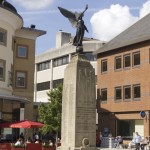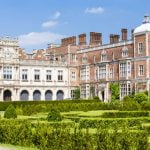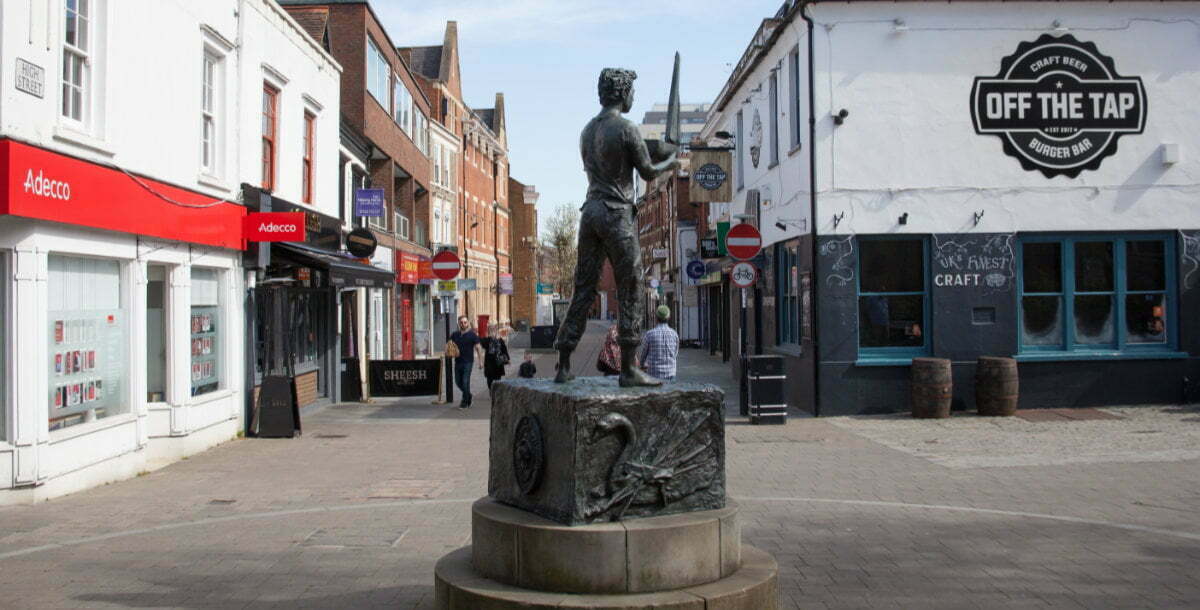
Everything you ever wanted to know about Maidenhead but were too afraid to ask.
Found on the southwestern bank of the River Thames, the town of Maidenhead has a population of 70,000 people. It is part of the County of Berkshire and is a good place to live if you are a commuter to the London area.
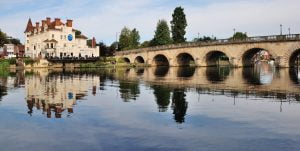
Image: Nina Alizada/Shutterstock.com
Today we’re taking a closer look at Maidenhead to find out if that is the staycation destination you have been dreaming of. Okay, so we won’t take it that far. But we at least want to know if it’s okay to visit for a day or if we will get chibbed in the car park.
Let’s talk about the history that made Maidenhead the beautiful, culture-rich town that it is today.
The Early Days of Maidenhead
Maidenhead has an exceptionally rich history to it. The start of which we can trace back to Roman times. When the Romans invaded Britain, they built several villas throughout the area and one of these was in Cox Green. You can learn about it at Maidenhead’s Heritage Centre to this day. The Romans retreated from the area around about 400 BC, but not before they set up a walled settlement called Alaunodunum. This town would have been in the same location as where Maidenhead now stands. However, it would have been abandoned after the Romans left. It wouldn’t have stayed abandoned for long, however, because of its proximity to the River Thames.
The Saxon Warrior King named Teappa was buried at Taplow near Maidenhead and the Witan was held there in the year 997. For those of you that don’t know what the Witan was, this was a collection of the elder men who advise the king in times of war or on matters of state. The year 870 saw a Viking army invade the Kingdom of Wessex. Wessex was the county from whence came King Alfred the Great – the man who united all of England together. It was the only state of England that didn’t succumb to Viking rule. The 870 AD invasion saw them come as far inland as Reading, as accounted in Brother Asser’s Accounts of Alfred. They were eventually beaten, however, or there wouldn’t be an England today.
Maidenhead’s name is a bit of a point of contestation. It is said to be named after the Riverside area where a new Wharf or “maiden hythe” was built in Saxon times. In the old Scots tongue, Maidenhead is another name for a virgin. So, the Virgin Harbour would be more accurate. However, it came to get its name, a ferry ran from here across the water and back for most of the Dark Ages.
At the time of the Domesday survey taken in 1086, Maidenhead had a recorded population of 10 households, which put it in the smallest 40% of all settlements in England. Commuting wasn’t really a thing before we had cars and trains. Only one owner was named, and this owner was responsible for six villagers and four Cottagers. His name was. Giles, brother of Ansculf. Giles also owned 16 acres of Meadow and woodland big enough to keep 10 renders of swine. In 1086, the land was valued at two pounds per annum.
Mediaeval Maidenhead
The first wooden bridge was built in the town across the River Thames in 1250. This would have made trade with the surrounding areas much more accessible. That would have also negated the need for the ferry to cross back and forth. Over the years, the bridge would be rebuilt in stone several times. The Guild of Saint Andrew and Saint Mary was founded in 1451, and the town received its first royal charter in 1582. A Royal charter enabled towns to hold a weekly market or hold an annual fair. With it, town officials could do things like pave, light, and clean the streets.
It is believed that the current area where the town sits would have been on top of the Anglo Saxon town which was named South Ellington. This is where the river would have been crossable, and on the way to the site of Alaunodunum. When that new bridge was built circa 1250 to 1280, the Great West Road, which ran from Bristol and Gloucester to Reading was diverted to cross here. This would have brought a huge influx of new traders to the area. The bridge that stands there now was built in 1777. The building cost 19,000 pounds.
So, it came to be that mediaeval Maidenhead grew as both a port town and as a market town. Saint Mary of Magdalene’s church was built in the 1300s and a coaching end was added to the High Street. Several inns grew up as the town became a passing place. This trend continued right into the industrial era when it was estimated that more than 90 coaches passed through the town every day. You can still see remnants of the town’s coaching heritage in the Bay Hotel on High Street.
Let’s stop there for a moment and remind ourselves of a few fun Maidenhead facts.
Fun trivia about Maidenhead
Whether you are in the area for a while or whether you are just passing through, here is some cool local knowledge that you can use to impress your friends at parties with. If they groan it’s totally not our fault.
Fun facts about Maidenhead:
- Before King Charles the First was executed, he met his children here at the Greyhound Inn, on the High Street. This was in 1649 and you can still see a plaque on the side of the NatWest Bank branch, which commemorates this final meeting.
- Maidenhead had its own sleazy hotel. In Edwardian times the Skindles Hotel developed a reputation for being scandalous. This was where you went to meet your secret lover.
- The 1838 railway bridge was the widest and flattest brick arch bridge built in the world at the time. at was built by expert architect Isambard Kingdom Brunel. There is a nice story about Brunel having to retain the wooden supports for the bridge because his masters at the Great Western Railway did not have faith that the bridge would stand on its own. The wooden posts were shortly washed away in a flood, and yet the stone bridge remains, 200 years later.
- the Cox Green Roman villa dates to 100 AD and is considered one of the oldest sprawling farm villas in the country. It was spotted in the 1950s when locals were taking aerial photography of the area.
- The Fat Duck in the Bray has been there since 1995 and is owned by Heston Blumenthal, the triple Michelin star chef. In2004 it was named the world’s best restaurant. If you are in town and you’re looking for somewhere to eat, make sure you book months in advance.
So, as you can see, there are plenty of fun facts flying around Maidenhead for you to sink your teeth into. Some of them. Let’s get back to the history and find out what happened next.
Maidenhead during the Industrial Revolution
The 17th-century kick-started the beginning of the Industrial Revolution in Maidenhead. The town received a charter from James the first in 1605, which allowed them to have their own mayor. An Almshouse was built by local do-gooder James Smythe, which could hold 8 poor couples. The Greyhound Inn, in Maidenhead, was where Charles first saw his children and 1649 for the final time. And then in 1688, there was a battle at Maidenhead Bridge between James II and William III. At least one of whom was on the way home from “populating” Ireland. Sorry Ireland.
It was in 1724 when we see the first written occurrence of the name Maidenhead instead of Ellington. In 1740 the first-ever performance of Rule Britannia was given at Cliveden. Boulter’s lock was built in the middle of the Thames. In 1777, as we mentioned above, the Maidenhead Bridge was built in stone and the coaching trade was the main source of income through town.
The railway bridge was completed in 1839 and Brunel named it the “sounding arch”. The coaching era finally started to die down because of the new technology the railway brought. In 1826 the local church of Saint Andrew and Mary Magdalene was rebuilt on top of the site of an earlier church. In 1835, the Cookham Union Workhouse was opened in the courthouse at Saint Mark’s Rd. In 1817, Maidenhead United Football Club was founded. They’re still going strong. And by 1891, the population of Maidenhead was 10,600 people. Two years later, the maiden Regatta was founded. And in 1894, the grammar school was first opened.
Also in 1894, the greatest flood to ever grace our records occurred in Maidenhead. Then in 1897, it was the Diamond Jubilee of Queen Victoria, so everyone had to get the sponges out. There was a toll on Maidenhead bridge up until 1903. When it was finally lifted, it had been in place for over 750 years.
Maidenhead, in the Modern Era
In the 1911 census, the population of Maidenhead had risen to a little over 15,000 people. During the First World War, 331 young men served and did not return home to Maidenhead. 900 casualties were recorded. Of such a small population, the young men of Maidenhead managed to accumulate 4 Victoria Crosses between them for remarkable bravery displayed at war. During the Second World War, 175 young men died and did not return home. These names were later added to the War Memorial that you can find in the centre of town.
Wars aside, the 1900s have proven efficient for growth in Maidenhead. In 1927, Ivor Novello bought red roofs at Littlewick green as a country house. In 1935 the White Waltham Aerodrome opened. During World War Two, the Air Transport Auxiliary HQ was established there. In 1947, the most severe flood of the 20th century was recorded, during which Maidenhead was mostly underwater. A Maidonian man named Bert Bushnell won the gold medal in London Olympic Games for men’s double sculls in 1948. Hammer House of Horror had a good bit of influence in the area when they opened studios in The Bray in 1950. They would make movies there until 1966.
In 1957 of Vanwall Racing car. Driven by Stirling Moss was the first British car to win a Grand Prix since 1934. In 1961, they finally completed the Maidenhead Bypass. It took 38 years to build. Release routes were added in 1972 to help the traffic. In 1972 Maidenhead got its first Public Library[i].
In 2002, the Maidenhead, Windsor, and Eton Flood Alleviation Scheme was opened. This is known as the Jubilee River and helps to protect against floods, such as what they have seen in the last few 100 years. The year after this, the Jubilee River saved Maidenhead. 2003 experienced the worst flooding since the 1947 event. Severe flooding was experienced from Cookham all the way to Hurley. In 2004, another two Maidonians won silver in the Athens Olympic Games for rowing.
Nowadays, Maidenhead is a great commuter town with a friendly vibe and a reputation for being welcoming… if a little expensive. They experience good weather, have plenty of history, and once played host to kings. We heart Maidenhead. Go visit and boost local tourism.
Famous people born in Maidenhead
for those of you who want to know who they can expect to rub shoulders with down in Sainsbury’s. Here are some of the five minutes spare favourite famous people to have come from Maidenhead:
- The artist, Sir Stanley Spencer. Ari was born in nearby Cookham in 1891. You might not meet him in Sainsbury’s, but you might appreciate some of his art in the local museum.
- James Blomfield, who is a stained glass artist in Canada.
- Director Jan Dunn is from here.
- DJ Fresh is a Maidenhead man.
- The writer Nick Hornby, who wrote ‘About a Boy.’
- Peter Jones from the Dragon’s Den.
And that’s the note we will leave it on, we think. Let’s review the best things to see and do in town, instead.
Top Attractions in Maidenhead
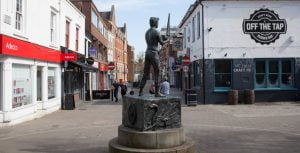
Image: Ben Molyneux/Shutterstock.com
Is Maidenhead a good location for those looking to book a UK holiday this year? Here are some of the best sights and sounds you will find in this lovely town.
Historic Sights and Landmarks
One of the top things to do in Maidenhead is to go to Boulters Lock and walk along to Ray Mill Island. Boulters Lock was built in the early 19th century to allow control over levels in the river. It has become a charming area of natural wildlife and a great place to walk among wildflower beds. It’s an accidental local landmark that became a sort of garden. Worth a tour.
Of course, one of the biggest landmarks and Maidenhead has been the sounding arch bridge since it was built in the 19th century. Rowing is quite a common hobby in Maidenhead, and this allows you to see the sounding arch from the underside. The bridge still sees used today as a railway bridge. If you happen to be a trainspotter, you can combine both loves into one visit. Incidentally, the sounding arch gives a great echo if you want to do some singing.
Galleries and Museums
The best museum in town is the Maidenhead Heritage Centre, which is also the home of the ATA. The ATA are the Air Transport Auxiliary which was set up in World War Two to help people get places during the war. This good combination of the two places allows for an in depth exploration and several exhibits on Maidenhead during the world wars. This is also where you find out most about the history of the town.
You will find the Stanley Spencer Gallery in town where you can view the artist’s memorabilia, among other things. You can access the John Lewis Partnership Heritage Centre in Maidenhead too, if you happen to love department stores.
Sport and Recreation
Not a sport, but something recreational; Norden Farm Centre for The Arts is the local theatre and it offers plenty of shows all year round. You can join local amateur dramatics groups here. You can take dance or acting classes, participate in the community behind Norden Farm, or even just go along for the cafe bar. Always check what’s on when you’re in town. If you want something unique to do.
There is a fishery in town. Have a look at Pondwood Fisheries to see what you can catch and how much it costs.
You can choose to Tee off at the Winter Hill Golf Club to the north of town, the Temple Golf Club to the west of town, the Huntswood Golf Club to the east of town, or the Maidenhead Golf Club on the southern end of town.
Maidenhead has its own rugby club, unimaginatively named Maidenhead RFC.
The local football team is called Maidenhead United FC and they are an FA standard charter club with three adult teams who play in the Thames Valley Premier League. You will find them at the York Road Stadium, which only has a little covered section so take your raincoat.
Outdoor Attractions
Maidenhead has its own zoo nearby! Go and say hello to the lovely foreign animals trapped here in the misery of the cold and wet. The BCA Zoo has everything from goats to monkeys for you to explore. Situated in this zoo you will find 29 mammals, 28 reptiles, 6 birds, 19 amphibians, and 17 invertebrates. If you go in springtime, you might be able to book a feeding session. Little kids love the idea of the petting zoo element. This zoo does a lot of animal conservation work as well, which makes up for keeping them in this cold climate.
Speaking of things that kids love, there is a park complete with playground at Ockwells Park which they can enjoy. The best thing about this playground is the cafe straight across from it where you can sit and enjoy a coffee while you still watch your children. Ockwells Park leads to forest and the Royal Borough of Windsor. This ancient forest is compiled of oak trees.
Eating in Maidenhead
There are lots of places to eat that should fit any appetite. You can try Presto Italian Street Food for a bite of European, or head to Veganushi for some vegan sushi. There’s also the Boathouse for some traditional but beautiful fare.
Shopping in Maidenhead
Most of the best shopping in town is in Nicholson’s Shopping Centre, which is near the town centre. There are plenty of supermarkets and even a craft section in the town centre.
Partying in Maidenhead
If you are staying in town for a night out, check out Smokey’s as a favourite venue among locals. Pitcher’s is a Nightclub and a Restaurant, so you can do both here, and then there’s the Honeypot. The less said about it, the better.
Other Notable Attractions
There are still a few Maidenhead attractions that we couldn’t quite fit into this article. Here are some of the things you should see if you’re there for any length of time:
- The Lillibrooke Manor and barns are wedding venues nowadays but still represent some picturesque scenery and architecture.
- The Braywick Nature Centre is popular for schools and group visits.
- Take the kids to Andrea’s café and soft play.
How to Get There?
We wouldn’t be good at our job if we didn’t include some directions, so here goes. FYI you should take a map.
By Road
Follow the M4 West until you reach the A308.
By Rail
Maidenhead Train Station is on the Great Western Line.
By Air
The nearest airport is London Heathrow.
By Sea
If you can sail the River Thames, you have sea access.
About Five Minutes Spare
We are cataloguing the best sights to see across the UK, right here on our pages. Join us for travel guides to try and find your hometown or follow us on Facebook to stay up to date.
[i] https://www.windsor.gov.uk/explore/maidenhead/history-of-maidenhead
https://en.wikipedia.org/wiki/Maidenhead
http://www.visitoruk.com/Maidenhead/20th-century-T4174.html



